Business Analysis Report: Tesco Plc, Data Analysis and Decision Making
VerifiedAdded on 2021/01/02
|17
|4829
|220
Report
AI Summary
This report provides a business analysis of Tesco Plc, a multinational retail firm. It begins with an introduction to business analysis and its application to Tesco's operational efficiency. The report then delves into key concepts such as population and simple random sampling, discussing their relevance to Tesco's efforts to address issues like increasing staff turnover. It explores the use of primary and secondary data in business analysis, including data collection methods such as interviews and questionnaires. The report also covers statistical calculations, including median and standard deviation, and their role in decision-making processes. The analysis considers how Tesco can leverage data to improve its practices and enhance employee satisfaction. The report concludes with a discussion of the role of appropriate data in the decision-making process, offering insights into Tesco's strategic considerations. References from various academic sources are included to support the analysis.
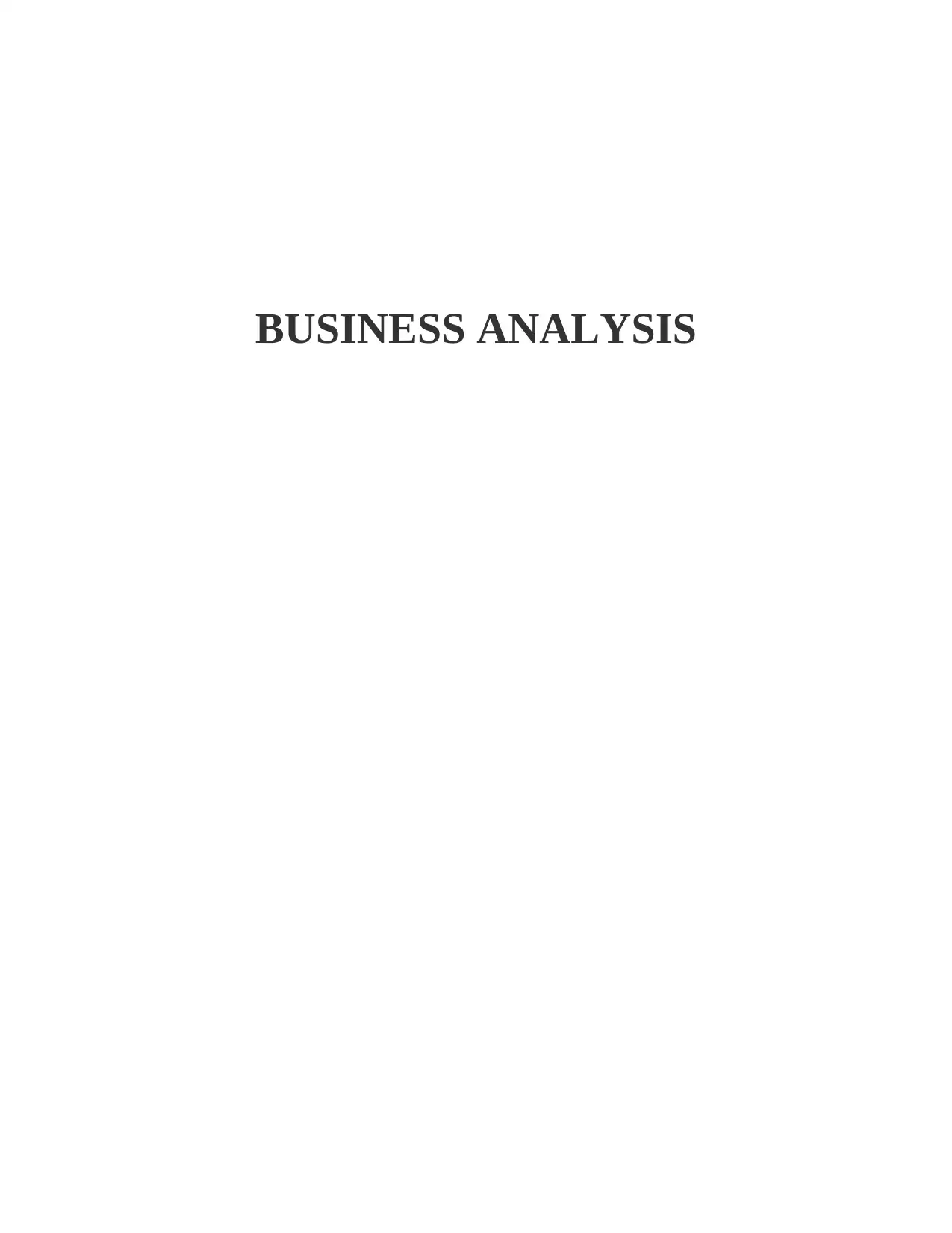
BUSINESS ANALYSIS
Paraphrase This Document
Need a fresh take? Get an instant paraphrase of this document with our AI Paraphraser
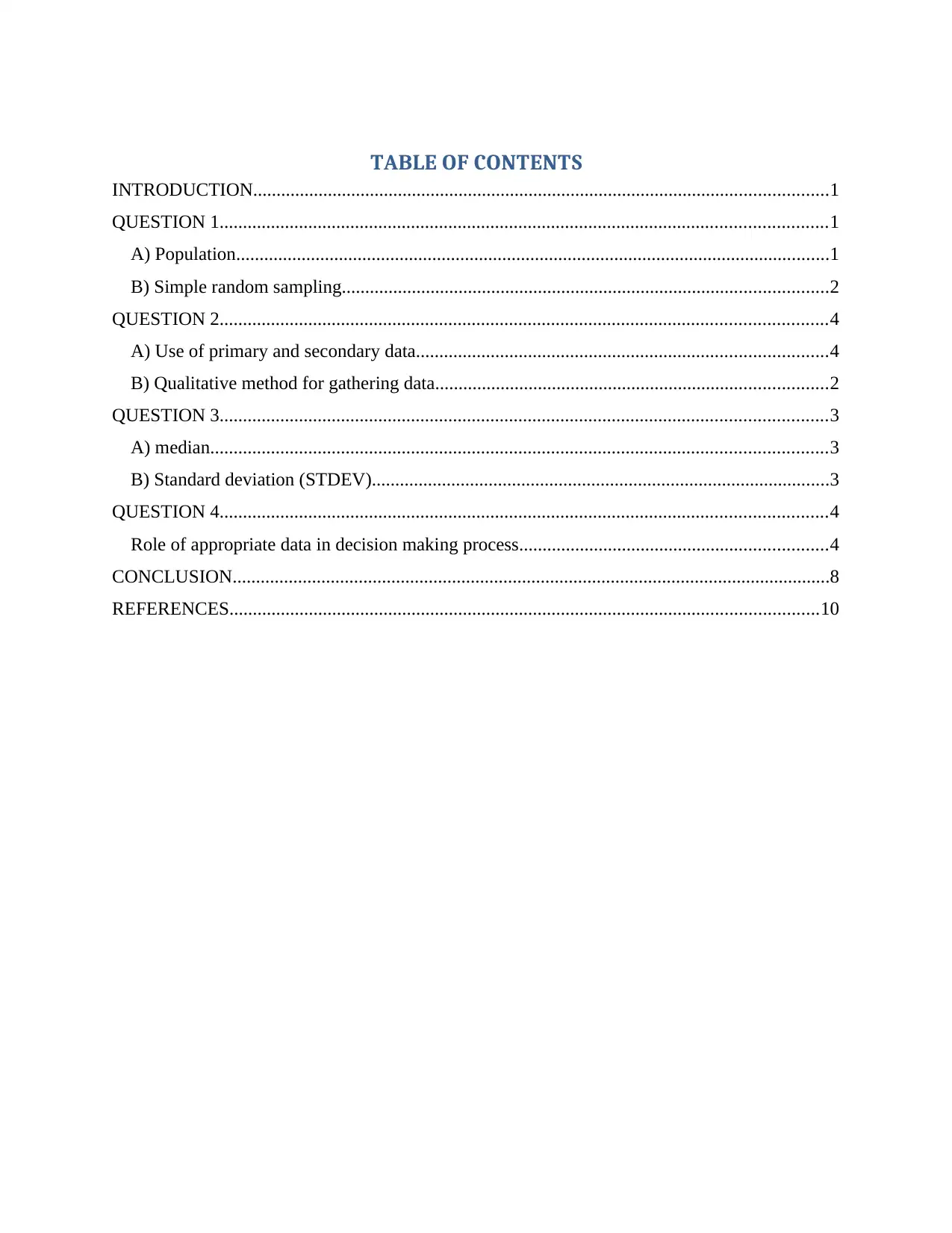
TABLE OF CONTENTS
INTRODUCTION...........................................................................................................................1
QUESTION 1..................................................................................................................................1
A) Population...............................................................................................................................1
B) Simple random sampling........................................................................................................2
QUESTION 2..................................................................................................................................4
A) Use of primary and secondary data........................................................................................4
B) Qualitative method for gathering data....................................................................................2
QUESTION 3..................................................................................................................................3
A) median....................................................................................................................................3
B) Standard deviation (STDEV)..................................................................................................3
QUESTION 4..................................................................................................................................4
Role of appropriate data in decision making process..................................................................4
CONCLUSION................................................................................................................................8
REFERENCES..............................................................................................................................10
INTRODUCTION...........................................................................................................................1
QUESTION 1..................................................................................................................................1
A) Population...............................................................................................................................1
B) Simple random sampling........................................................................................................2
QUESTION 2..................................................................................................................................4
A) Use of primary and secondary data........................................................................................4
B) Qualitative method for gathering data....................................................................................2
QUESTION 3..................................................................................................................................3
A) median....................................................................................................................................3
B) Standard deviation (STDEV)..................................................................................................3
QUESTION 4..................................................................................................................................4
Role of appropriate data in decision making process..................................................................4
CONCLUSION................................................................................................................................8
REFERENCES..............................................................................................................................10

INTRODUCTION
Business analysis is considered as technique that supports organisation in investigating
about their performance and implementing necessary changes effectively (Padilla and et.al.,
2015). Present study is based on Tesco Plc, which is a multinational retail firm that operates its
business across the world. Over a period of time, Tesco has made several modifications in its
practices to improve operational efficiency. In the year 2015, Tesco has been rewarded as the
only retailer in UK that offers products to consumers at reasonable prices. The current
assignment will explain terms with respect to population and simple random sampling.
Furthermore, it will use primary and secondary data for business analysis. In addition, median
with standard deviation calculations will be performed with reference to Tesco Plc.
QUESTION 1
A) Population
Tesco Plc is continuously working for improving quality of products and services. Its main
agenda is to increase satisfaction level of buyers and make them loyal towards the brand. Over a
period of time, company has experienced decreasing sales issue, due to which overall revenues
have been declined. Increasing competition has created trouble for firm which has realised to
make changes in its practices so that it can sustain in the market for longer duration (Kandola
and et.al, 2014).
Tesco treats its consumers well and always try to serve the best to shoppers. Recently
management of company has identified that staff turnover is increasing. So, it wants to determine
whether providing flexible working hours would be worthwhile options or not to resolve this
turnover problem.
Research population can be defined as large collection of individuals with common
characteristics. It is divided into two major categories: target and accessible. Target people is the
group to whom Scholar wishes to involve in study to find out answers to problems. On the other
hand, accessible people are such individuals who are easily accessible to researcher (Orcher,
2016). There is huge difference between sample and populace. As population is the set of people
who exist in universe whereas sample refers to data of people who are being involved in
investigation to find out answers.
1
Business analysis is considered as technique that supports organisation in investigating
about their performance and implementing necessary changes effectively (Padilla and et.al.,
2015). Present study is based on Tesco Plc, which is a multinational retail firm that operates its
business across the world. Over a period of time, Tesco has made several modifications in its
practices to improve operational efficiency. In the year 2015, Tesco has been rewarded as the
only retailer in UK that offers products to consumers at reasonable prices. The current
assignment will explain terms with respect to population and simple random sampling.
Furthermore, it will use primary and secondary data for business analysis. In addition, median
with standard deviation calculations will be performed with reference to Tesco Plc.
QUESTION 1
A) Population
Tesco Plc is continuously working for improving quality of products and services. Its main
agenda is to increase satisfaction level of buyers and make them loyal towards the brand. Over a
period of time, company has experienced decreasing sales issue, due to which overall revenues
have been declined. Increasing competition has created trouble for firm which has realised to
make changes in its practices so that it can sustain in the market for longer duration (Kandola
and et.al, 2014).
Tesco treats its consumers well and always try to serve the best to shoppers. Recently
management of company has identified that staff turnover is increasing. So, it wants to determine
whether providing flexible working hours would be worthwhile options or not to resolve this
turnover problem.
Research population can be defined as large collection of individuals with common
characteristics. It is divided into two major categories: target and accessible. Target people is the
group to whom Scholar wishes to involve in study to find out answers to problems. On the other
hand, accessible people are such individuals who are easily accessible to researcher (Orcher,
2016). There is huge difference between sample and populace. As population is the set of people
who exist in universe whereas sample refers to data of people who are being involved in
investigation to find out answers.
1
⊘ This is a preview!⊘
Do you want full access?
Subscribe today to unlock all pages.

Trusted by 1+ million students worldwide
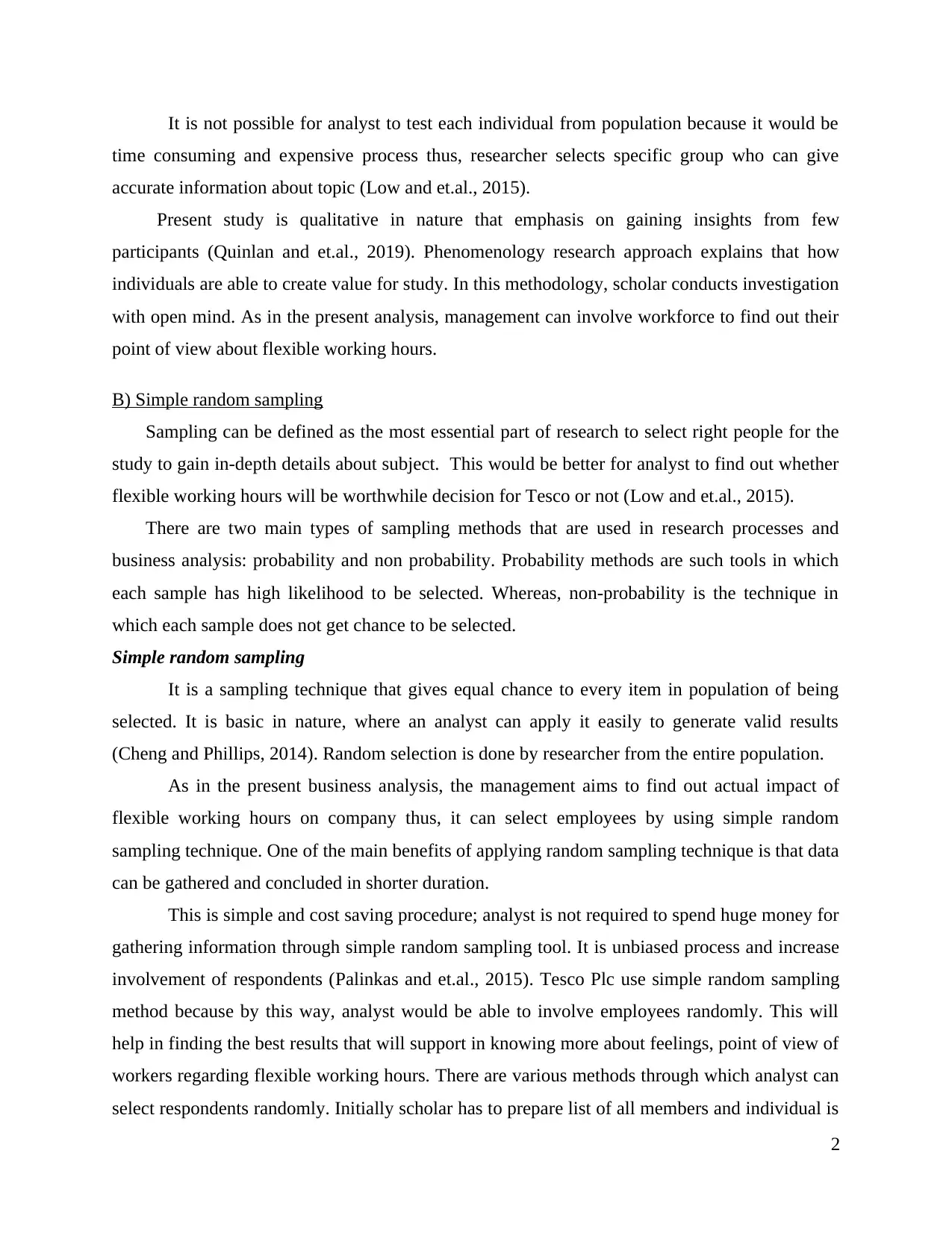
It is not possible for analyst to test each individual from population because it would be
time consuming and expensive process thus, researcher selects specific group who can give
accurate information about topic (Low and et.al., 2015).
Present study is qualitative in nature that emphasis on gaining insights from few
participants (Quinlan and et.al., 2019). Phenomenology research approach explains that how
individuals are able to create value for study. In this methodology, scholar conducts investigation
with open mind. As in the present analysis, management can involve workforce to find out their
point of view about flexible working hours.
B) Simple random sampling
Sampling can be defined as the most essential part of research to select right people for the
study to gain in-depth details about subject. This would be better for analyst to find out whether
flexible working hours will be worthwhile decision for Tesco or not (Low and et.al., 2015).
There are two main types of sampling methods that are used in research processes and
business analysis: probability and non probability. Probability methods are such tools in which
each sample has high likelihood to be selected. Whereas, non-probability is the technique in
which each sample does not get chance to be selected.
Simple random sampling
It is a sampling technique that gives equal chance to every item in population of being
selected. It is basic in nature, where an analyst can apply it easily to generate valid results
(Cheng and Phillips, 2014). Random selection is done by researcher from the entire population.
As in the present business analysis, the management aims to find out actual impact of
flexible working hours on company thus, it can select employees by using simple random
sampling technique. One of the main benefits of applying random sampling technique is that data
can be gathered and concluded in shorter duration.
This is simple and cost saving procedure; analyst is not required to spend huge money for
gathering information through simple random sampling tool. It is unbiased process and increase
involvement of respondents (Palinkas and et.al., 2015). Tesco Plc use simple random sampling
method because by this way, analyst would be able to involve employees randomly. This will
help in finding the best results that will support in knowing more about feelings, point of view of
workers regarding flexible working hours. There are various methods through which analyst can
select respondents randomly. Initially scholar has to prepare list of all members and individual is
2
time consuming and expensive process thus, researcher selects specific group who can give
accurate information about topic (Low and et.al., 2015).
Present study is qualitative in nature that emphasis on gaining insights from few
participants (Quinlan and et.al., 2019). Phenomenology research approach explains that how
individuals are able to create value for study. In this methodology, scholar conducts investigation
with open mind. As in the present analysis, management can involve workforce to find out their
point of view about flexible working hours.
B) Simple random sampling
Sampling can be defined as the most essential part of research to select right people for the
study to gain in-depth details about subject. This would be better for analyst to find out whether
flexible working hours will be worthwhile decision for Tesco or not (Low and et.al., 2015).
There are two main types of sampling methods that are used in research processes and
business analysis: probability and non probability. Probability methods are such tools in which
each sample has high likelihood to be selected. Whereas, non-probability is the technique in
which each sample does not get chance to be selected.
Simple random sampling
It is a sampling technique that gives equal chance to every item in population of being
selected. It is basic in nature, where an analyst can apply it easily to generate valid results
(Cheng and Phillips, 2014). Random selection is done by researcher from the entire population.
As in the present business analysis, the management aims to find out actual impact of
flexible working hours on company thus, it can select employees by using simple random
sampling technique. One of the main benefits of applying random sampling technique is that data
can be gathered and concluded in shorter duration.
This is simple and cost saving procedure; analyst is not required to spend huge money for
gathering information through simple random sampling tool. It is unbiased process and increase
involvement of respondents (Palinkas and et.al., 2015). Tesco Plc use simple random sampling
method because by this way, analyst would be able to involve employees randomly. This will
help in finding the best results that will support in knowing more about feelings, point of view of
workers regarding flexible working hours. There are various methods through which analyst can
select respondents randomly. Initially scholar has to prepare list of all members and individual is
2
Paraphrase This Document
Need a fresh take? Get an instant paraphrase of this document with our AI Paraphraser
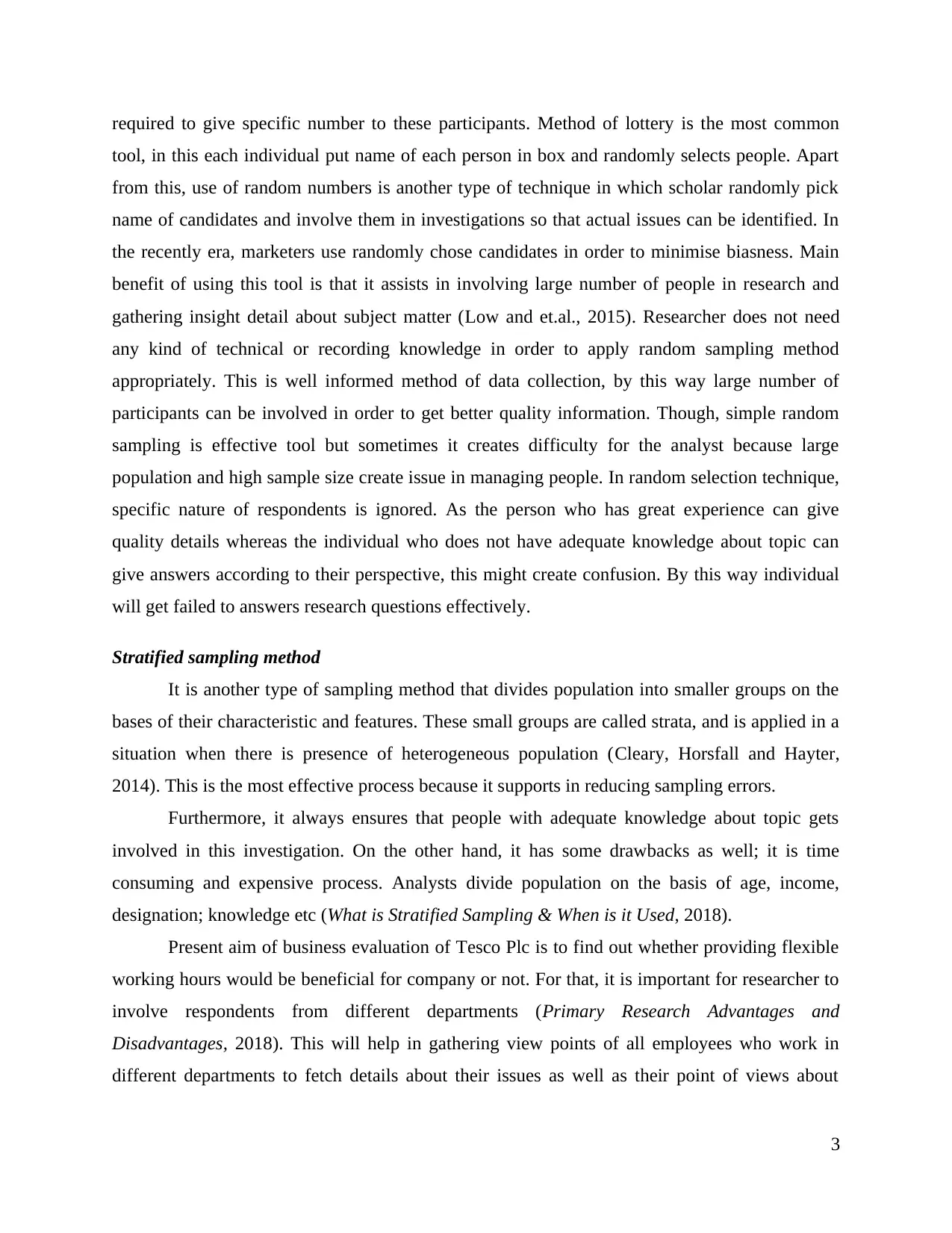
required to give specific number to these participants. Method of lottery is the most common
tool, in this each individual put name of each person in box and randomly selects people. Apart
from this, use of random numbers is another type of technique in which scholar randomly pick
name of candidates and involve them in investigations so that actual issues can be identified. In
the recently era, marketers use randomly chose candidates in order to minimise biasness. Main
benefit of using this tool is that it assists in involving large number of people in research and
gathering insight detail about subject matter (Low and et.al., 2015). Researcher does not need
any kind of technical or recording knowledge in order to apply random sampling method
appropriately. This is well informed method of data collection, by this way large number of
participants can be involved in order to get better quality information. Though, simple random
sampling is effective tool but sometimes it creates difficulty for the analyst because large
population and high sample size create issue in managing people. In random selection technique,
specific nature of respondents is ignored. As the person who has great experience can give
quality details whereas the individual who does not have adequate knowledge about topic can
give answers according to their perspective, this might create confusion. By this way individual
will get failed to answers research questions effectively.
Stratified sampling method
It is another type of sampling method that divides population into smaller groups on the
bases of their characteristic and features. These small groups are called strata, and is applied in a
situation when there is presence of heterogeneous population (Cleary, Horsfall and Hayter,
2014). This is the most effective process because it supports in reducing sampling errors.
Furthermore, it always ensures that people with adequate knowledge about topic gets
involved in this investigation. On the other hand, it has some drawbacks as well; it is time
consuming and expensive process. Analysts divide population on the basis of age, income,
designation; knowledge etc (What is Stratified Sampling & When is it Used, 2018).
Present aim of business evaluation of Tesco Plc is to find out whether providing flexible
working hours would be beneficial for company or not. For that, it is important for researcher to
involve respondents from different departments (Primary Research Advantages and
Disadvantages, 2018). This will help in gathering view points of all employees who work in
different departments to fetch details about their issues as well as their point of views about
3
tool, in this each individual put name of each person in box and randomly selects people. Apart
from this, use of random numbers is another type of technique in which scholar randomly pick
name of candidates and involve them in investigations so that actual issues can be identified. In
the recently era, marketers use randomly chose candidates in order to minimise biasness. Main
benefit of using this tool is that it assists in involving large number of people in research and
gathering insight detail about subject matter (Low and et.al., 2015). Researcher does not need
any kind of technical or recording knowledge in order to apply random sampling method
appropriately. This is well informed method of data collection, by this way large number of
participants can be involved in order to get better quality information. Though, simple random
sampling is effective tool but sometimes it creates difficulty for the analyst because large
population and high sample size create issue in managing people. In random selection technique,
specific nature of respondents is ignored. As the person who has great experience can give
quality details whereas the individual who does not have adequate knowledge about topic can
give answers according to their perspective, this might create confusion. By this way individual
will get failed to answers research questions effectively.
Stratified sampling method
It is another type of sampling method that divides population into smaller groups on the
bases of their characteristic and features. These small groups are called strata, and is applied in a
situation when there is presence of heterogeneous population (Cleary, Horsfall and Hayter,
2014). This is the most effective process because it supports in reducing sampling errors.
Furthermore, it always ensures that people with adequate knowledge about topic gets
involved in this investigation. On the other hand, it has some drawbacks as well; it is time
consuming and expensive process. Analysts divide population on the basis of age, income,
designation; knowledge etc (What is Stratified Sampling & When is it Used, 2018).
Present aim of business evaluation of Tesco Plc is to find out whether providing flexible
working hours would be beneficial for company or not. For that, it is important for researcher to
involve respondents from different departments (Primary Research Advantages and
Disadvantages, 2018). This will help in gathering view points of all employees who work in
different departments to fetch details about their issues as well as their point of views about
3
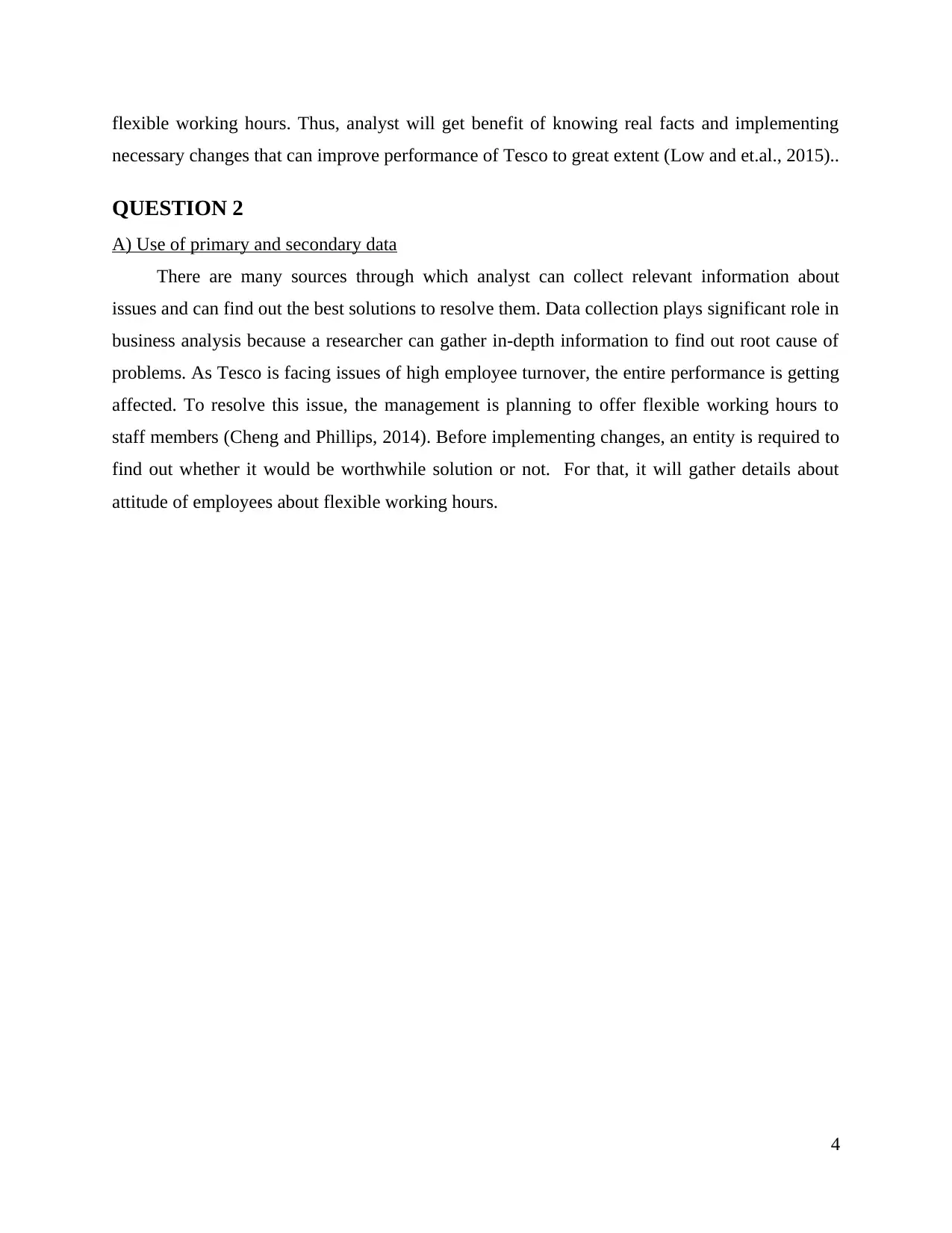
flexible working hours. Thus, analyst will get benefit of knowing real facts and implementing
necessary changes that can improve performance of Tesco to great extent (Low and et.al., 2015)..
QUESTION 2
A) Use of primary and secondary data
There are many sources through which analyst can collect relevant information about
issues and can find out the best solutions to resolve them. Data collection plays significant role in
business analysis because a researcher can gather in-depth information to find out root cause of
problems. As Tesco is facing issues of high employee turnover, the entire performance is getting
affected. To resolve this issue, the management is planning to offer flexible working hours to
staff members (Cheng and Phillips, 2014). Before implementing changes, an entity is required to
find out whether it would be worthwhile solution or not. For that, it will gather details about
attitude of employees about flexible working hours.
4
necessary changes that can improve performance of Tesco to great extent (Low and et.al., 2015)..
QUESTION 2
A) Use of primary and secondary data
There are many sources through which analyst can collect relevant information about
issues and can find out the best solutions to resolve them. Data collection plays significant role in
business analysis because a researcher can gather in-depth information to find out root cause of
problems. As Tesco is facing issues of high employee turnover, the entire performance is getting
affected. To resolve this issue, the management is planning to offer flexible working hours to
staff members (Cheng and Phillips, 2014). Before implementing changes, an entity is required to
find out whether it would be worthwhile solution or not. For that, it will gather details about
attitude of employees about flexible working hours.
4
⊘ This is a preview!⊘
Do you want full access?
Subscribe today to unlock all pages.

Trusted by 1+ million students worldwide
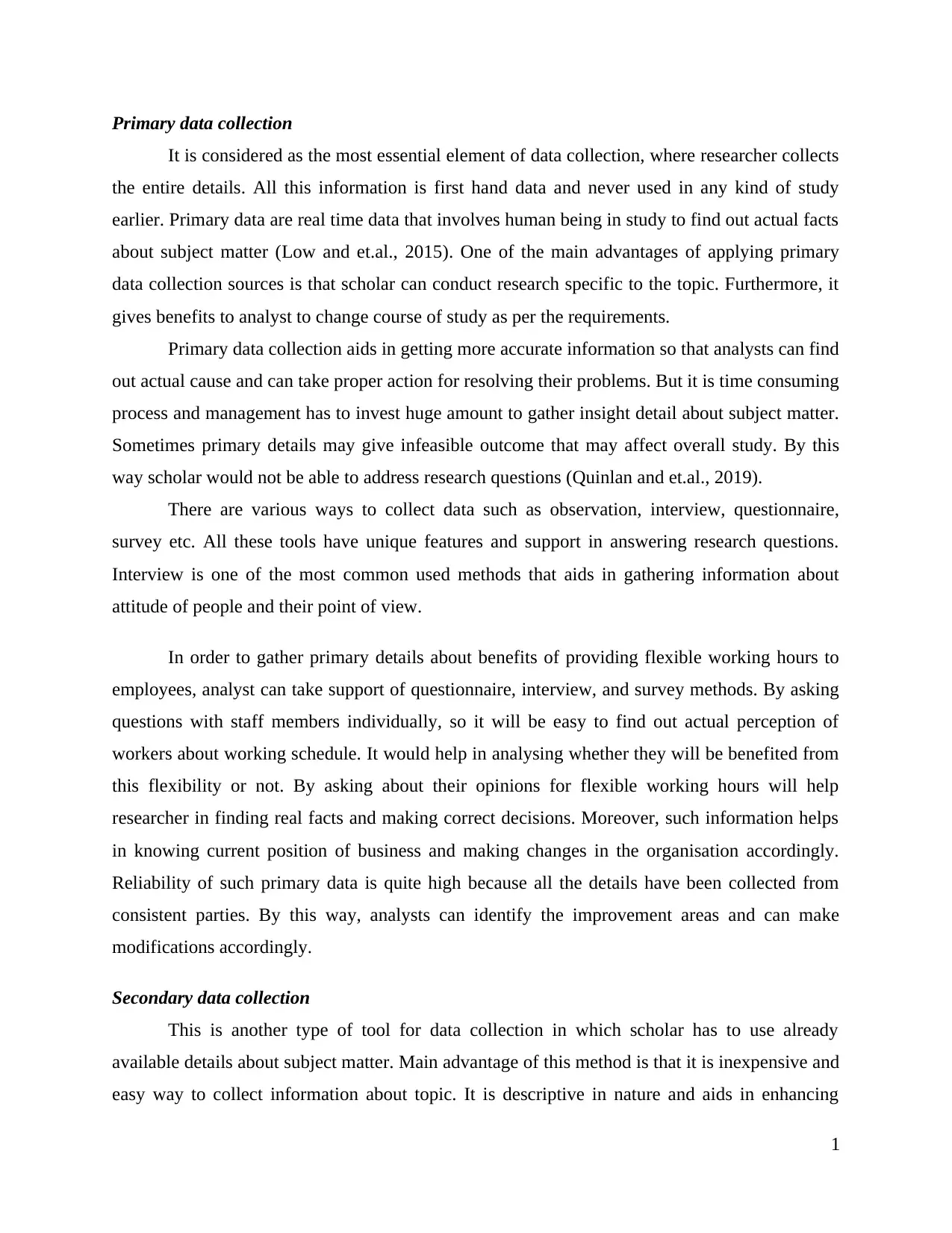
Primary data collection
It is considered as the most essential element of data collection, where researcher collects
the entire details. All this information is first hand data and never used in any kind of study
earlier. Primary data are real time data that involves human being in study to find out actual facts
about subject matter (Low and et.al., 2015). One of the main advantages of applying primary
data collection sources is that scholar can conduct research specific to the topic. Furthermore, it
gives benefits to analyst to change course of study as per the requirements.
Primary data collection aids in getting more accurate information so that analysts can find
out actual cause and can take proper action for resolving their problems. But it is time consuming
process and management has to invest huge amount to gather insight detail about subject matter.
Sometimes primary details may give infeasible outcome that may affect overall study. By this
way scholar would not be able to address research questions (Quinlan and et.al., 2019).
There are various ways to collect data such as observation, interview, questionnaire,
survey etc. All these tools have unique features and support in answering research questions.
Interview is one of the most common used methods that aids in gathering information about
attitude of people and their point of view.
In order to gather primary details about benefits of providing flexible working hours to
employees, analyst can take support of questionnaire, interview, and survey methods. By asking
questions with staff members individually, so it will be easy to find out actual perception of
workers about working schedule. It would help in analysing whether they will be benefited from
this flexibility or not. By asking about their opinions for flexible working hours will help
researcher in finding real facts and making correct decisions. Moreover, such information helps
in knowing current position of business and making changes in the organisation accordingly.
Reliability of such primary data is quite high because all the details have been collected from
consistent parties. By this way, analysts can identify the improvement areas and can make
modifications accordingly.
Secondary data collection
This is another type of tool for data collection in which scholar has to use already
available details about subject matter. Main advantage of this method is that it is inexpensive and
easy way to collect information about topic. It is descriptive in nature and aids in enhancing
1
It is considered as the most essential element of data collection, where researcher collects
the entire details. All this information is first hand data and never used in any kind of study
earlier. Primary data are real time data that involves human being in study to find out actual facts
about subject matter (Low and et.al., 2015). One of the main advantages of applying primary
data collection sources is that scholar can conduct research specific to the topic. Furthermore, it
gives benefits to analyst to change course of study as per the requirements.
Primary data collection aids in getting more accurate information so that analysts can find
out actual cause and can take proper action for resolving their problems. But it is time consuming
process and management has to invest huge amount to gather insight detail about subject matter.
Sometimes primary details may give infeasible outcome that may affect overall study. By this
way scholar would not be able to address research questions (Quinlan and et.al., 2019).
There are various ways to collect data such as observation, interview, questionnaire,
survey etc. All these tools have unique features and support in answering research questions.
Interview is one of the most common used methods that aids in gathering information about
attitude of people and their point of view.
In order to gather primary details about benefits of providing flexible working hours to
employees, analyst can take support of questionnaire, interview, and survey methods. By asking
questions with staff members individually, so it will be easy to find out actual perception of
workers about working schedule. It would help in analysing whether they will be benefited from
this flexibility or not. By asking about their opinions for flexible working hours will help
researcher in finding real facts and making correct decisions. Moreover, such information helps
in knowing current position of business and making changes in the organisation accordingly.
Reliability of such primary data is quite high because all the details have been collected from
consistent parties. By this way, analysts can identify the improvement areas and can make
modifications accordingly.
Secondary data collection
This is another type of tool for data collection in which scholar has to use already
available details about subject matter. Main advantage of this method is that it is inexpensive and
easy way to collect information about topic. It is descriptive in nature and aids in enhancing
1
Paraphrase This Document
Need a fresh take? Get an instant paraphrase of this document with our AI Paraphraser
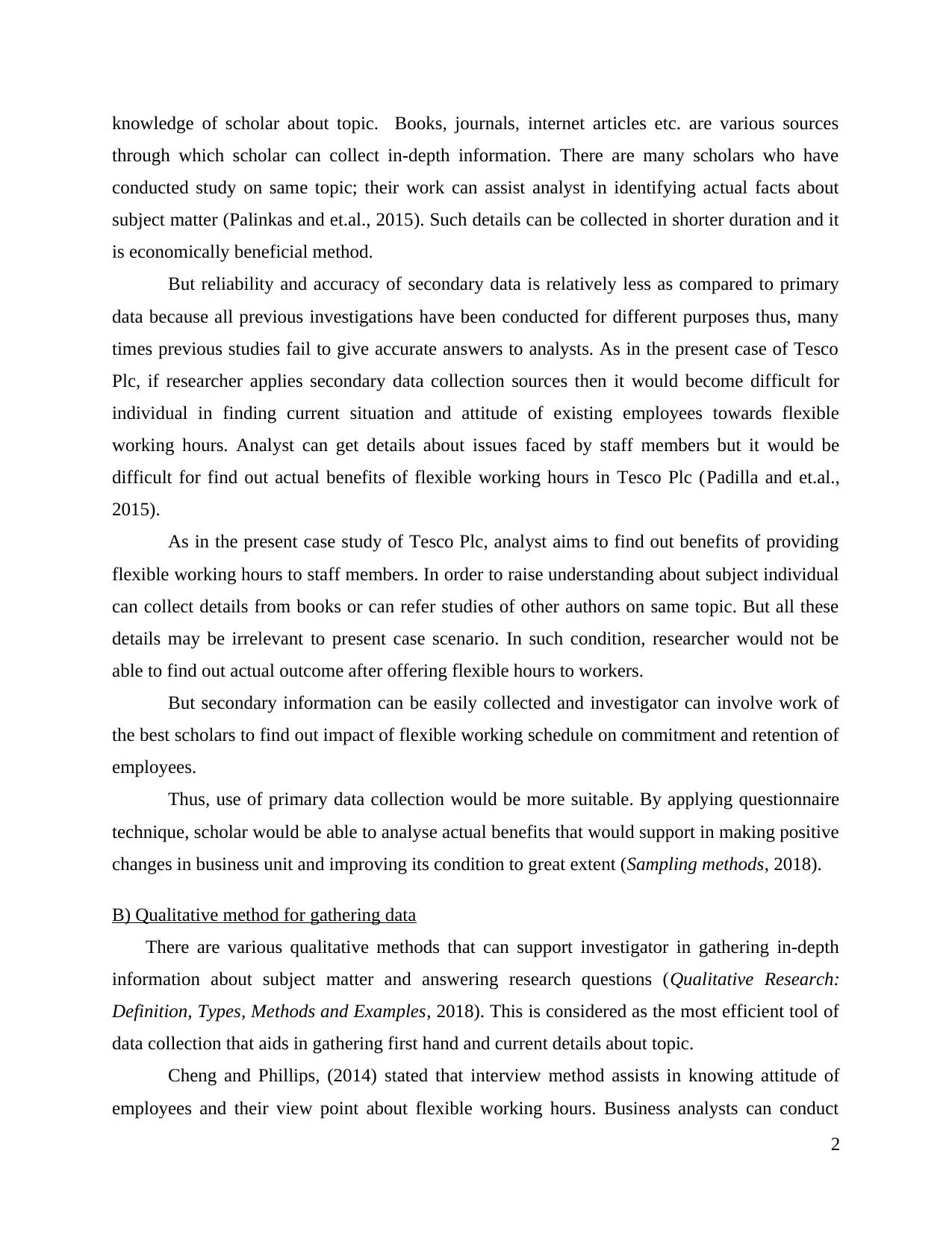
knowledge of scholar about topic. Books, journals, internet articles etc. are various sources
through which scholar can collect in-depth information. There are many scholars who have
conducted study on same topic; their work can assist analyst in identifying actual facts about
subject matter (Palinkas and et.al., 2015). Such details can be collected in shorter duration and it
is economically beneficial method.
But reliability and accuracy of secondary data is relatively less as compared to primary
data because all previous investigations have been conducted for different purposes thus, many
times previous studies fail to give accurate answers to analysts. As in the present case of Tesco
Plc, if researcher applies secondary data collection sources then it would become difficult for
individual in finding current situation and attitude of existing employees towards flexible
working hours. Analyst can get details about issues faced by staff members but it would be
difficult for find out actual benefits of flexible working hours in Tesco Plc (Padilla and et.al.,
2015).
As in the present case study of Tesco Plc, analyst aims to find out benefits of providing
flexible working hours to staff members. In order to raise understanding about subject individual
can collect details from books or can refer studies of other authors on same topic. But all these
details may be irrelevant to present case scenario. In such condition, researcher would not be
able to find out actual outcome after offering flexible hours to workers.
But secondary information can be easily collected and investigator can involve work of
the best scholars to find out impact of flexible working schedule on commitment and retention of
employees.
Thus, use of primary data collection would be more suitable. By applying questionnaire
technique, scholar would be able to analyse actual benefits that would support in making positive
changes in business unit and improving its condition to great extent (Sampling methods, 2018).
B) Qualitative method for gathering data
There are various qualitative methods that can support investigator in gathering in-depth
information about subject matter and answering research questions (Qualitative Research:
Definition, Types, Methods and Examples, 2018). This is considered as the most efficient tool of
data collection that aids in gathering first hand and current details about topic.
Cheng and Phillips, (2014) stated that interview method assists in knowing attitude of
employees and their view point about flexible working hours. Business analysts can conduct
2
through which scholar can collect in-depth information. There are many scholars who have
conducted study on same topic; their work can assist analyst in identifying actual facts about
subject matter (Palinkas and et.al., 2015). Such details can be collected in shorter duration and it
is economically beneficial method.
But reliability and accuracy of secondary data is relatively less as compared to primary
data because all previous investigations have been conducted for different purposes thus, many
times previous studies fail to give accurate answers to analysts. As in the present case of Tesco
Plc, if researcher applies secondary data collection sources then it would become difficult for
individual in finding current situation and attitude of existing employees towards flexible
working hours. Analyst can get details about issues faced by staff members but it would be
difficult for find out actual benefits of flexible working hours in Tesco Plc (Padilla and et.al.,
2015).
As in the present case study of Tesco Plc, analyst aims to find out benefits of providing
flexible working hours to staff members. In order to raise understanding about subject individual
can collect details from books or can refer studies of other authors on same topic. But all these
details may be irrelevant to present case scenario. In such condition, researcher would not be
able to find out actual outcome after offering flexible hours to workers.
But secondary information can be easily collected and investigator can involve work of
the best scholars to find out impact of flexible working schedule on commitment and retention of
employees.
Thus, use of primary data collection would be more suitable. By applying questionnaire
technique, scholar would be able to analyse actual benefits that would support in making positive
changes in business unit and improving its condition to great extent (Sampling methods, 2018).
B) Qualitative method for gathering data
There are various qualitative methods that can support investigator in gathering in-depth
information about subject matter and answering research questions (Qualitative Research:
Definition, Types, Methods and Examples, 2018). This is considered as the most efficient tool of
data collection that aids in gathering first hand and current details about topic.
Cheng and Phillips, (2014) stated that interview method assists in knowing attitude of
employees and their view point about flexible working hours. Business analysts can conduct
2
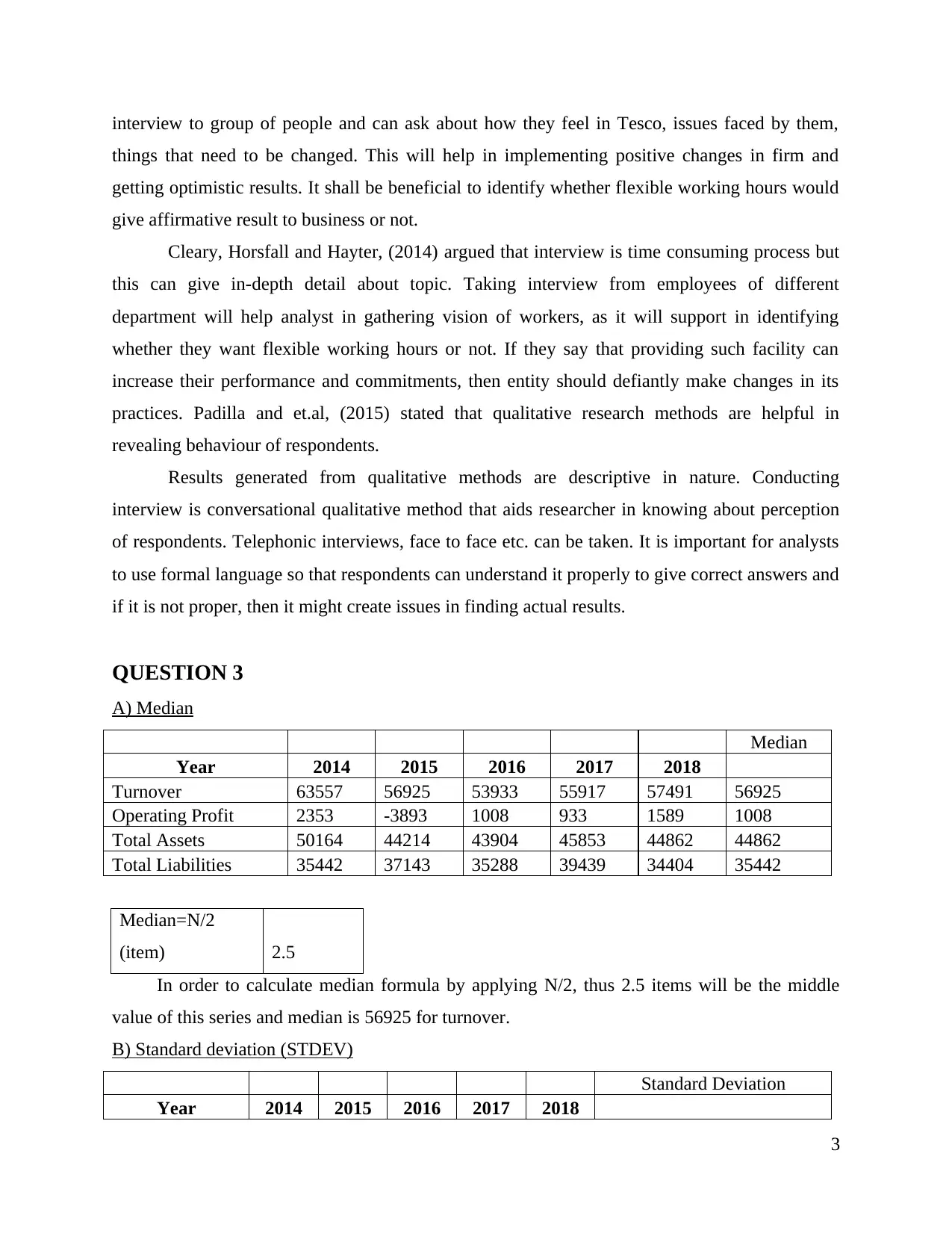
interview to group of people and can ask about how they feel in Tesco, issues faced by them,
things that need to be changed. This will help in implementing positive changes in firm and
getting optimistic results. It shall be beneficial to identify whether flexible working hours would
give affirmative result to business or not.
Cleary, Horsfall and Hayter, (2014) argued that interview is time consuming process but
this can give in-depth detail about topic. Taking interview from employees of different
department will help analyst in gathering vision of workers, as it will support in identifying
whether they want flexible working hours or not. If they say that providing such facility can
increase their performance and commitments, then entity should defiantly make changes in its
practices. Padilla and et.al, (2015) stated that qualitative research methods are helpful in
revealing behaviour of respondents.
Results generated from qualitative methods are descriptive in nature. Conducting
interview is conversational qualitative method that aids researcher in knowing about perception
of respondents. Telephonic interviews, face to face etc. can be taken. It is important for analysts
to use formal language so that respondents can understand it properly to give correct answers and
if it is not proper, then it might create issues in finding actual results.
QUESTION 3
A) Median
Median
Year 2014 2015 2016 2017 2018
Turnover 63557 56925 53933 55917 57491 56925
Operating Profit 2353 -3893 1008 933 1589 1008
Total Assets 50164 44214 43904 45853 44862 44862
Total Liabilities 35442 37143 35288 39439 34404 35442
Median=N/2
(item) 2.5
In order to calculate median formula by applying N/2, thus 2.5 items will be the middle
value of this series and median is 56925 for turnover.
B) Standard deviation (STDEV)
Standard Deviation
Year 2014 2015 2016 2017 2018
3
things that need to be changed. This will help in implementing positive changes in firm and
getting optimistic results. It shall be beneficial to identify whether flexible working hours would
give affirmative result to business or not.
Cleary, Horsfall and Hayter, (2014) argued that interview is time consuming process but
this can give in-depth detail about topic. Taking interview from employees of different
department will help analyst in gathering vision of workers, as it will support in identifying
whether they want flexible working hours or not. If they say that providing such facility can
increase their performance and commitments, then entity should defiantly make changes in its
practices. Padilla and et.al, (2015) stated that qualitative research methods are helpful in
revealing behaviour of respondents.
Results generated from qualitative methods are descriptive in nature. Conducting
interview is conversational qualitative method that aids researcher in knowing about perception
of respondents. Telephonic interviews, face to face etc. can be taken. It is important for analysts
to use formal language so that respondents can understand it properly to give correct answers and
if it is not proper, then it might create issues in finding actual results.
QUESTION 3
A) Median
Median
Year 2014 2015 2016 2017 2018
Turnover 63557 56925 53933 55917 57491 56925
Operating Profit 2353 -3893 1008 933 1589 1008
Total Assets 50164 44214 43904 45853 44862 44862
Total Liabilities 35442 37143 35288 39439 34404 35442
Median=N/2
(item) 2.5
In order to calculate median formula by applying N/2, thus 2.5 items will be the middle
value of this series and median is 56925 for turnover.
B) Standard deviation (STDEV)
Standard Deviation
Year 2014 2015 2016 2017 2018
3
⊘ This is a preview!⊘
Do you want full access?
Subscribe today to unlock all pages.

Trusted by 1+ million students worldwide
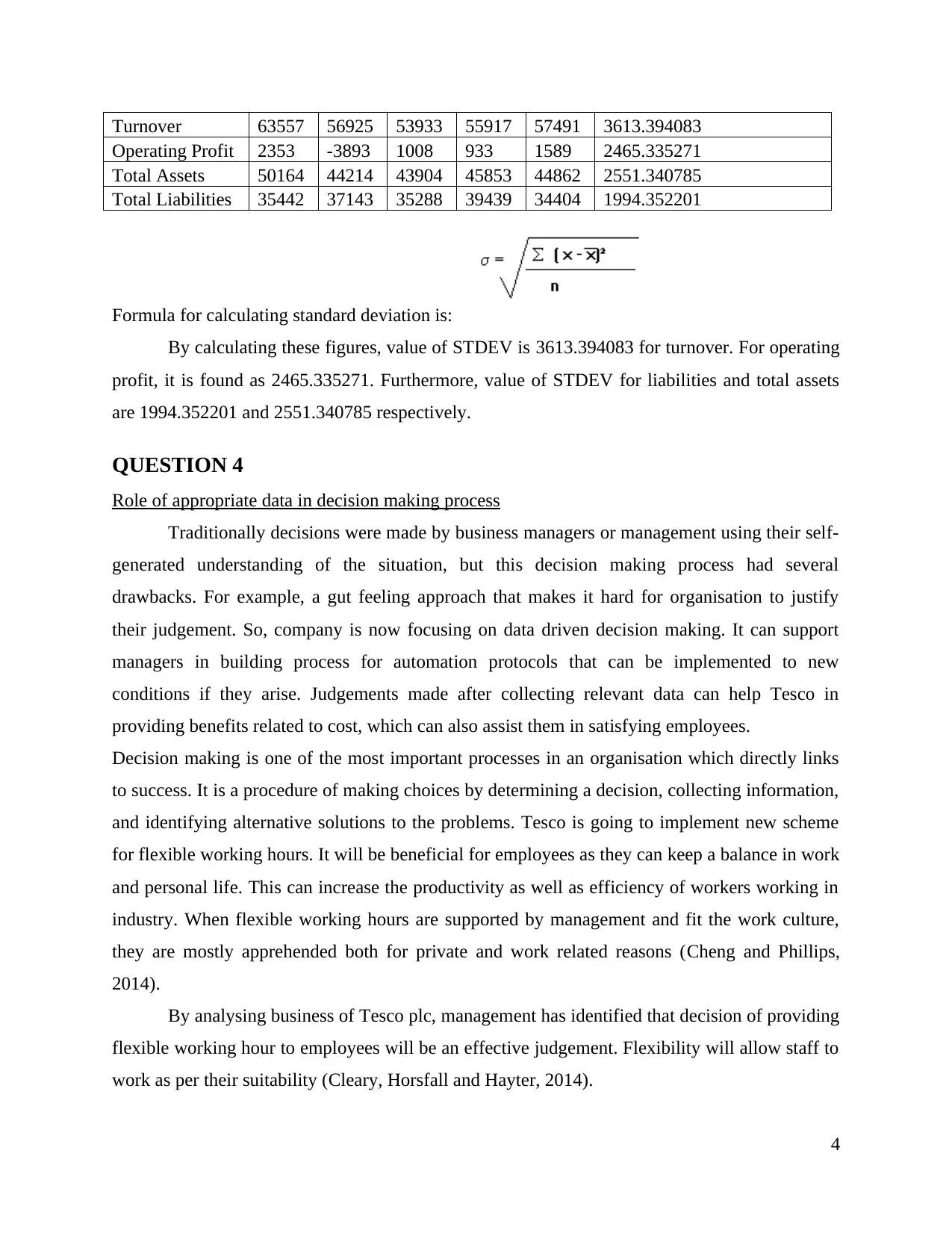
Turnover 63557 56925 53933 55917 57491 3613.394083
Operating Profit 2353 -3893 1008 933 1589 2465.335271
Total Assets 50164 44214 43904 45853 44862 2551.340785
Total Liabilities 35442 37143 35288 39439 34404 1994.352201
Formula for calculating standard deviation is:
By calculating these figures, value of STDEV is 3613.394083 for turnover. For operating
profit, it is found as 2465.335271. Furthermore, value of STDEV for liabilities and total assets
are 1994.352201 and 2551.340785 respectively.
QUESTION 4
Role of appropriate data in decision making process
Traditionally decisions were made by business managers or management using their self-
generated understanding of the situation, but this decision making process had several
drawbacks. For example, a gut feeling approach that makes it hard for organisation to justify
their judgement. So, company is now focusing on data driven decision making. It can support
managers in building process for automation protocols that can be implemented to new
conditions if they arise. Judgements made after collecting relevant data can help Tesco in
providing benefits related to cost, which can also assist them in satisfying employees.
Decision making is one of the most important processes in an organisation which directly links
to success. It is a procedure of making choices by determining a decision, collecting information,
and identifying alternative solutions to the problems. Tesco is going to implement new scheme
for flexible working hours. It will be beneficial for employees as they can keep a balance in work
and personal life. This can increase the productivity as well as efficiency of workers working in
industry. When flexible working hours are supported by management and fit the work culture,
they are mostly apprehended both for private and work related reasons (Cheng and Phillips,
2014).
By analysing business of Tesco plc, management has identified that decision of providing
flexible working hour to employees will be an effective judgement. Flexibility will allow staff to
work as per their suitability (Cleary, Horsfall and Hayter, 2014).
4
Operating Profit 2353 -3893 1008 933 1589 2465.335271
Total Assets 50164 44214 43904 45853 44862 2551.340785
Total Liabilities 35442 37143 35288 39439 34404 1994.352201
Formula for calculating standard deviation is:
By calculating these figures, value of STDEV is 3613.394083 for turnover. For operating
profit, it is found as 2465.335271. Furthermore, value of STDEV for liabilities and total assets
are 1994.352201 and 2551.340785 respectively.
QUESTION 4
Role of appropriate data in decision making process
Traditionally decisions were made by business managers or management using their self-
generated understanding of the situation, but this decision making process had several
drawbacks. For example, a gut feeling approach that makes it hard for organisation to justify
their judgement. So, company is now focusing on data driven decision making. It can support
managers in building process for automation protocols that can be implemented to new
conditions if they arise. Judgements made after collecting relevant data can help Tesco in
providing benefits related to cost, which can also assist them in satisfying employees.
Decision making is one of the most important processes in an organisation which directly links
to success. It is a procedure of making choices by determining a decision, collecting information,
and identifying alternative solutions to the problems. Tesco is going to implement new scheme
for flexible working hours. It will be beneficial for employees as they can keep a balance in work
and personal life. This can increase the productivity as well as efficiency of workers working in
industry. When flexible working hours are supported by management and fit the work culture,
they are mostly apprehended both for private and work related reasons (Cheng and Phillips,
2014).
By analysing business of Tesco plc, management has identified that decision of providing
flexible working hour to employees will be an effective judgement. Flexibility will allow staff to
work as per their suitability (Cleary, Horsfall and Hayter, 2014).
4
Paraphrase This Document
Need a fresh take? Get an instant paraphrase of this document with our AI Paraphraser
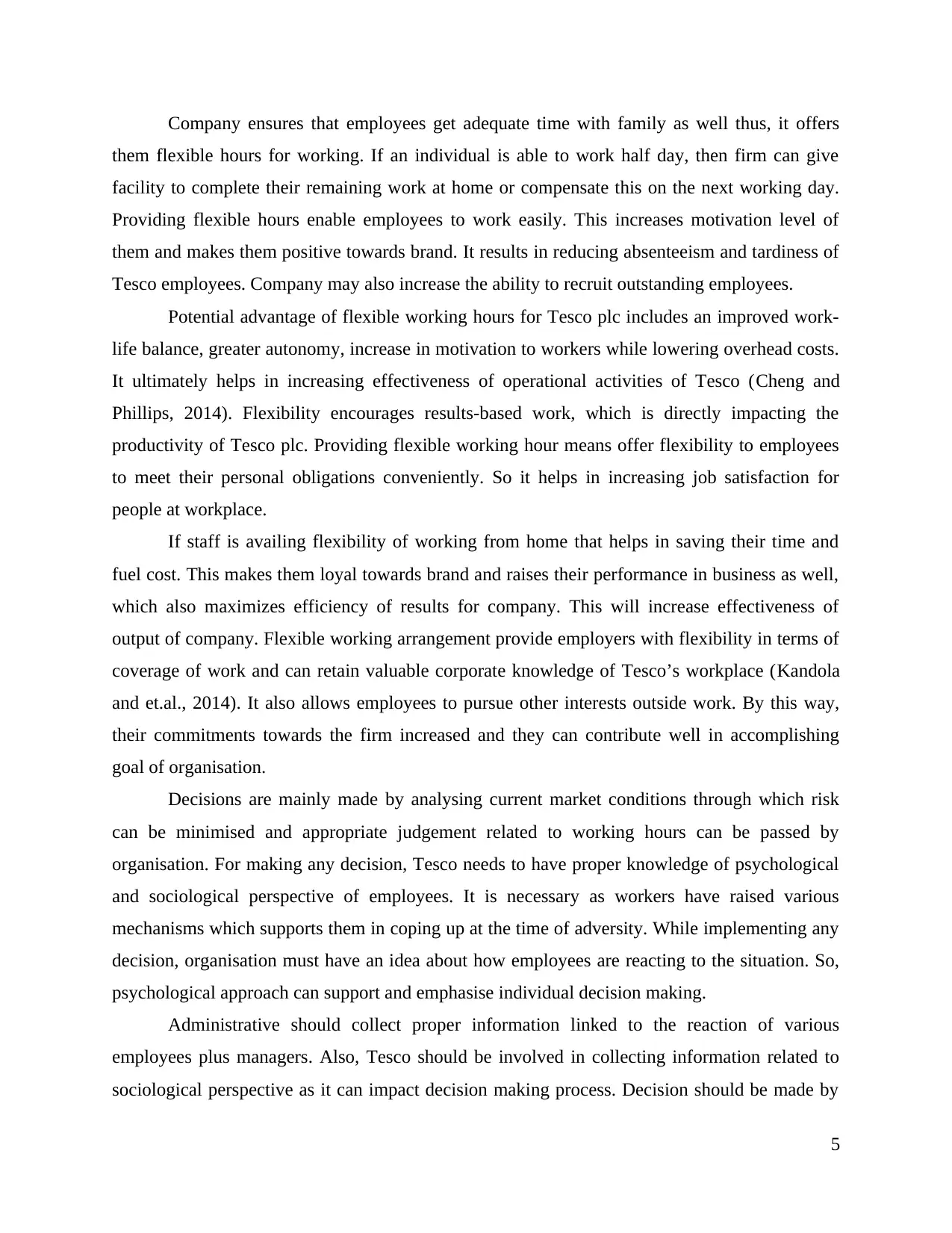
Company ensures that employees get adequate time with family as well thus, it offers
them flexible hours for working. If an individual is able to work half day, then firm can give
facility to complete their remaining work at home or compensate this on the next working day.
Providing flexible hours enable employees to work easily. This increases motivation level of
them and makes them positive towards brand. It results in reducing absenteeism and tardiness of
Tesco employees. Company may also increase the ability to recruit outstanding employees.
Potential advantage of flexible working hours for Tesco plc includes an improved work-
life balance, greater autonomy, increase in motivation to workers while lowering overhead costs.
It ultimately helps in increasing effectiveness of operational activities of Tesco (Cheng and
Phillips, 2014). Flexibility encourages results-based work, which is directly impacting the
productivity of Tesco plc. Providing flexible working hour means offer flexibility to employees
to meet their personal obligations conveniently. So it helps in increasing job satisfaction for
people at workplace.
If staff is availing flexibility of working from home that helps in saving their time and
fuel cost. This makes them loyal towards brand and raises their performance in business as well,
which also maximizes efficiency of results for company. This will increase effectiveness of
output of company. Flexible working arrangement provide employers with flexibility in terms of
coverage of work and can retain valuable corporate knowledge of Tesco’s workplace (Kandola
and et.al., 2014). It also allows employees to pursue other interests outside work. By this way,
their commitments towards the firm increased and they can contribute well in accomplishing
goal of organisation.
Decisions are mainly made by analysing current market conditions through which risk
can be minimised and appropriate judgement related to working hours can be passed by
organisation. For making any decision, Tesco needs to have proper knowledge of psychological
and sociological perspective of employees. It is necessary as workers have raised various
mechanisms which supports them in coping up at the time of adversity. While implementing any
decision, organisation must have an idea about how employees are reacting to the situation. So,
psychological approach can support and emphasise individual decision making.
Administrative should collect proper information linked to the reaction of various
employees plus managers. Also, Tesco should be involved in collecting information related to
sociological perspective as it can impact decision making process. Decision should be made by
5
them flexible hours for working. If an individual is able to work half day, then firm can give
facility to complete their remaining work at home or compensate this on the next working day.
Providing flexible hours enable employees to work easily. This increases motivation level of
them and makes them positive towards brand. It results in reducing absenteeism and tardiness of
Tesco employees. Company may also increase the ability to recruit outstanding employees.
Potential advantage of flexible working hours for Tesco plc includes an improved work-
life balance, greater autonomy, increase in motivation to workers while lowering overhead costs.
It ultimately helps in increasing effectiveness of operational activities of Tesco (Cheng and
Phillips, 2014). Flexibility encourages results-based work, which is directly impacting the
productivity of Tesco plc. Providing flexible working hour means offer flexibility to employees
to meet their personal obligations conveniently. So it helps in increasing job satisfaction for
people at workplace.
If staff is availing flexibility of working from home that helps in saving their time and
fuel cost. This makes them loyal towards brand and raises their performance in business as well,
which also maximizes efficiency of results for company. This will increase effectiveness of
output of company. Flexible working arrangement provide employers with flexibility in terms of
coverage of work and can retain valuable corporate knowledge of Tesco’s workplace (Kandola
and et.al., 2014). It also allows employees to pursue other interests outside work. By this way,
their commitments towards the firm increased and they can contribute well in accomplishing
goal of organisation.
Decisions are mainly made by analysing current market conditions through which risk
can be minimised and appropriate judgement related to working hours can be passed by
organisation. For making any decision, Tesco needs to have proper knowledge of psychological
and sociological perspective of employees. It is necessary as workers have raised various
mechanisms which supports them in coping up at the time of adversity. While implementing any
decision, organisation must have an idea about how employees are reacting to the situation. So,
psychological approach can support and emphasise individual decision making.
Administrative should collect proper information linked to the reaction of various
employees plus managers. Also, Tesco should be involved in collecting information related to
sociological perspective as it can impact decision making process. Decision should be made by
5
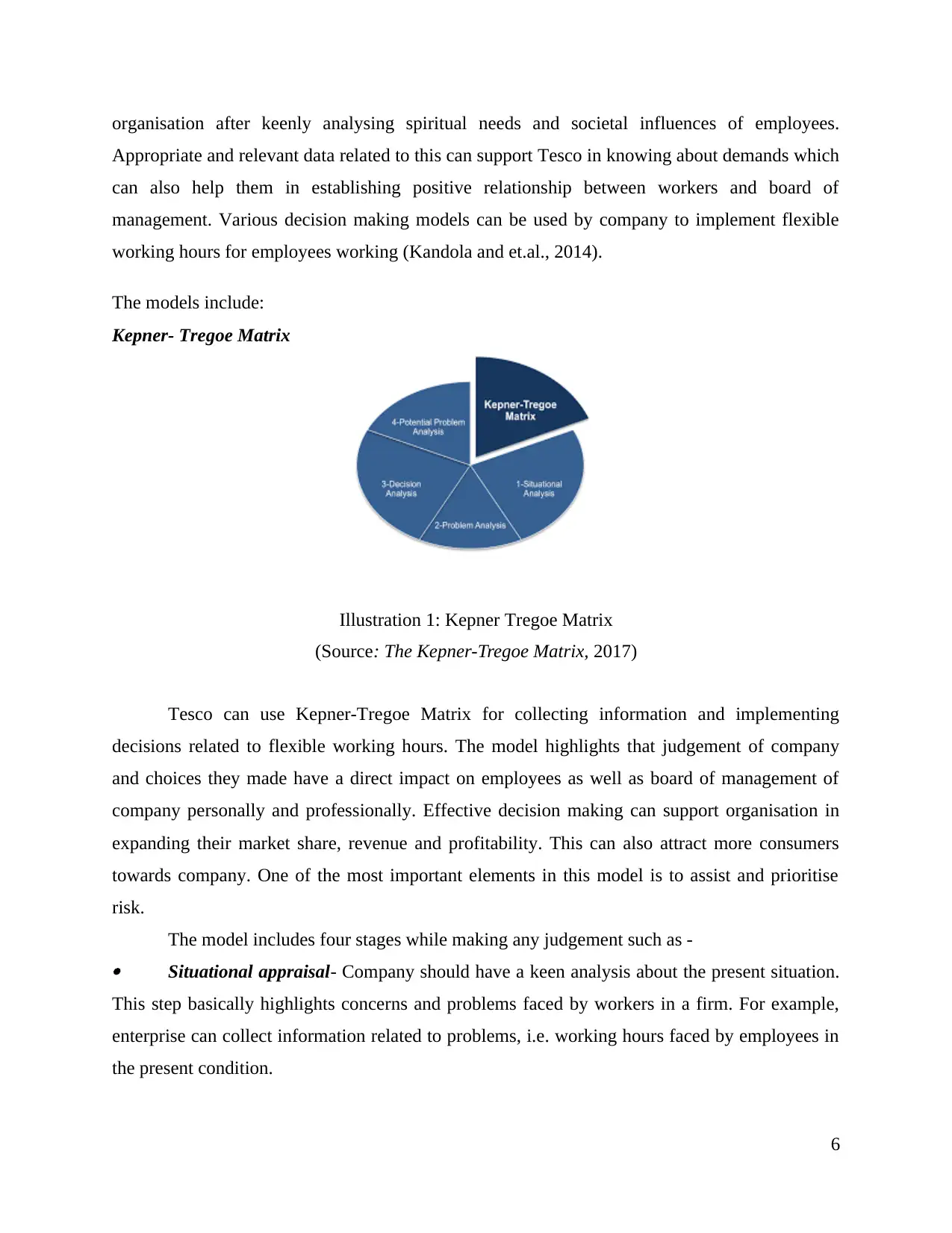
organisation after keenly analysing spiritual needs and societal influences of employees.
Appropriate and relevant data related to this can support Tesco in knowing about demands which
can also help them in establishing positive relationship between workers and board of
management. Various decision making models can be used by company to implement flexible
working hours for employees working (Kandola and et.al., 2014).
The models include:
Kepner- Tregoe Matrix
Illustration 1: Kepner Tregoe Matrix
(Source: The Kepner-Tregoe Matrix, 2017)
Tesco can use Kepner-Tregoe Matrix for collecting information and implementing
decisions related to flexible working hours. The model highlights that judgement of company
and choices they made have a direct impact on employees as well as board of management of
company personally and professionally. Effective decision making can support organisation in
expanding their market share, revenue and profitability. This can also attract more consumers
towards company. One of the most important elements in this model is to assist and prioritise
risk.
The model includes four stages while making any judgement such as - Situational appraisal- Company should have a keen analysis about the present situation.
This step basically highlights concerns and problems faced by workers in a firm. For example,
enterprise can collect information related to problems, i.e. working hours faced by employees in
the present condition.
6
Appropriate and relevant data related to this can support Tesco in knowing about demands which
can also help them in establishing positive relationship between workers and board of
management. Various decision making models can be used by company to implement flexible
working hours for employees working (Kandola and et.al., 2014).
The models include:
Kepner- Tregoe Matrix
Illustration 1: Kepner Tregoe Matrix
(Source: The Kepner-Tregoe Matrix, 2017)
Tesco can use Kepner-Tregoe Matrix for collecting information and implementing
decisions related to flexible working hours. The model highlights that judgement of company
and choices they made have a direct impact on employees as well as board of management of
company personally and professionally. Effective decision making can support organisation in
expanding their market share, revenue and profitability. This can also attract more consumers
towards company. One of the most important elements in this model is to assist and prioritise
risk.
The model includes four stages while making any judgement such as - Situational appraisal- Company should have a keen analysis about the present situation.
This step basically highlights concerns and problems faced by workers in a firm. For example,
enterprise can collect information related to problems, i.e. working hours faced by employees in
the present condition.
6
⊘ This is a preview!⊘
Do you want full access?
Subscribe today to unlock all pages.

Trusted by 1+ million students worldwide
1 out of 17
Related Documents
Your All-in-One AI-Powered Toolkit for Academic Success.
+13062052269
info@desklib.com
Available 24*7 on WhatsApp / Email
![[object Object]](/_next/static/media/star-bottom.7253800d.svg)
Unlock your academic potential
Copyright © 2020–2025 A2Z Services. All Rights Reserved. Developed and managed by ZUCOL.




